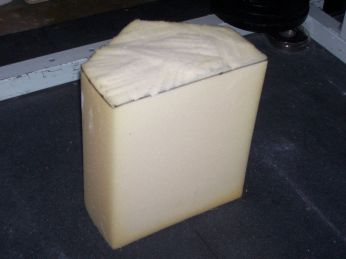
Fitness for One and All Home Page
Books and eBooks by the Director
Foam Squat Box
In the fall of 2007, I was having problems hitting depth on squats. I even missed my last attempt at my recent contest on depth. So I’ve been trying to figure out a system to be sure I’m hitting depth in training. I tried squatting down to a wooden box for depth checking a while back. But I didn’t like using it as I felt like I had to slow down to keep from hitting the box too hard. And when I hit the box, I felt like it was stopping me, which is considerably different from a regular squat. Also, if I missed a rep, especially with gear, I was afraid I could be “trapped” and have to dump the bar farther than I’d like onto the safety bars of my power rack. But I had another idea.
Back when I was crippled with low back pain, I put foam “wedges” under my knees when I would lie down (see Overcoming Back Pain). For what I am referring to here, see Knee Rest Pillow.
I had just recently thrown some out since I no longer need them, but fortunately, I still had a couple of these wedges. So I figured cutting one as need be and setting it on edge might work. So I cut one (using a small saw) to about the same height as my wood squat box, and I tried that in a workout. See the following pic (click for a larger image).
But the problem was, I couldn’t feel the foam too well until I really sunk into it. And it wasn’t a large enough of a “target,” so I had a hard time hitting it. I was also afraid it might tip over. So to make it larger, I cut parts of the other wedge and added that to it by duct taping it all together. I then duct taped the foam onto a piece of wood, and added another piece of wood on top. I figured the wood on the bottom would keep it from tipping over, and the wood on the top would enable me to feel it better when I sat on it.
I tried that for my next workout, and it worked much better. But in reviewing the videos, the depth looked just good enough. But I wanted to have it set so there was not doubt about it. So I took the top board off and shaved off a half inch or so, and re-taped it. It doesn't look very nice, but it worked great. See the following pics of the finished product.
The advantage of using foam over wood is, with the foam, if I come down hard it will squash down. But I don’t feel like the foam is strong enough to help me come back up. So it is more natural. And if I miss a rep, I can sink as low into the foam as needed to place the bar on the safeties.
The following video is from my first workout with the finished foam box.
I think the depth looks more than good enough here. In fact, in this workout, it felt like I was going too low. But I’d rather get used to going too low than too high. So hopefully, this foam box will solve my depth problems. I’ll know that if I hit the box, my depth is fine. So I won’t have to waste time during my workouts taking videos.
Incidentally, the song playing in the above video is “King of Kings” by Barren Cross, a Christian heavy metal group. This is one of my favorite songs.
Foam Squat Box. Copyright © 2007 By Gary F. Zeolla.
For a follow up to this post, see Extra Low Foam Squat Box.
Powerlifting and Back Pain
The first book is geared towards the beginner to intermediate powerlifter. It presents sound training, competition, dietary, and supplement advice to aid the reader in starting and progressing in the sport of powerlifting. The second book details how I overcame years of crippling low back and was able to return to the sport of powerlifting.
Starting and Progressing in Powerlifting: A Comprehensive Guide to the World's Strongest Sport
Overcoming Back Pain: A Mind-body Solution (Second Edition)
See also this series on Amazon (#ad).
The above article was posted on this site on October 30. 2007.
It was updated September 8, 2014.
![]() Powerlifting and Strength Training
Powerlifting and Strength Training
![]() Text
Search
Text
Search ![]() Alphabetical
List of Pages
Alphabetical
List of Pages ![]() Contact
Information
Contact
Information
![]() Fitness
for One and All Home Page
Fitness
for One and All Home Page
Books and eBooks by the Director